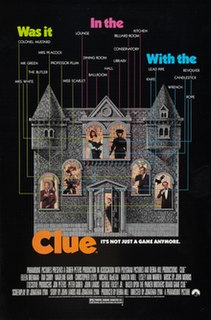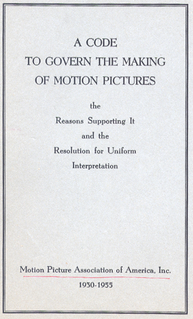
Clue is a 1985 American mystery black comedy film based on the board game of the same name. Directed by Jonathan Lynn, who collaborated on the script with John Landis, and produced by Debra Hill, it stars the ensemble cast of Eileen Brennan, Tim Curry, Madeline Kahn, Christopher Lloyd, Michael McKean, Martin Mull, Lesley Ann Warren, and Colleen Camp.

Scarface is a 1932 American pre-Code gangster film directed by Howard Hawks and produced by Hawks and Howard Hughes. The screenplay, by Ben Hecht, is based loosely on the 1929 novel by Armitage Trail which was inspired by Al Capone. The film stars Paul Muni as Italian immigrant gangster Antonio "Tony" Camonte, a gangster who violently rises through the Chicago gangland, with a supporting cast that includes George Raft and Boris Karloff. Camonte's rise to power dovetails with his relentless pursuit of his boss's mistress while his own sister pursues his best hitman. In an overt tie to the life of Capone, one scene depicts a version of the Saint Valentine's Day Massacre.

The Motion Picture Production Code was a set of industry guidelines for the self-censorship of content that was applied to most motion pictures released by major studios in the United States from 1934 to 1968. It is also popularly known as the Hays Code, after Will H. Hays, president of the Motion Picture Producers and Distributors of America (MPPDA) from 1922 to 1945. Under Hays's leadership, the MPPDA, later the Motion Picture Association of America (MPAA) and the Motion Picture Association (MPA), adopted the Production Code in 1930 and began rigidly enforcing it in 1934. The Production Code spelled out acceptable and unacceptable content for motion pictures produced for a public audience in the United States.

Cinema in Canada dates back to the earliest known display of film in Saint-Laurent, Quebec, in 1896. The film industry in Canada has been dominated by the United States, which has utilized Canada as a shooting location and to bypass British film quota laws, throughout its history. Canadian filmmakers, English and French, have been active in the development of cinema in the United States.

William Harrison Hays Sr. was an American Republican politician.
The National Legion of Decency, also known as the Catholic Legion of Decency, was a Catholic group founded in 1934 by Archbishop of Cincinnati, John T. McNicholas, as an organization dedicated to identifying for Catholic audiences, objectionable content in motion pictures. Members were asked to pledge to patronize only those motion pictures which did not "offend decency and Christian morality". The concept soon gained support from other churches.

Waterloo Bridge is a 1940 remake of the 1931 American drama film also called Waterloo Bridge, adapted from the 1930 play Waterloo Bridge. In an extended flashback narration, it recounts the story of a dancer and an army captain who meet by chance on Waterloo Bridge. The film was made by Metro-Goldwyn-Mayer, directed by Mervyn LeRoy and produced by Sidney Franklin and Mervyn LeRoy. The screenplay is by S. N. Behrman, Hans Rameau and George Froeschel, based on the Broadway drama by Robert E. Sherwood. The music is by Herbert Stothart and cinematography by Joseph Ruttenberg.

Pre-Code Hollywood was the brief era in the American film industry between the widespread adoption of sound in film in 1929 and the enforcement of the Motion Picture Production Code censorship guidelines, popularly known as the "Hays Code", in mid-1934. Although the Code was adopted in 1930, oversight was poor, and it did not become rigorously enforced until July 1, 1934, with the establishment of the Production Code Administration (PCA). Before that date, film content was restricted more by local laws, negotiations between the Studio Relations Committee (SRC) and the major studios, and popular opinion, than by strict adherence to the Hays Code, which was often ignored by Hollywood filmmakers.
In Canada, appeals by the judiciary to community standards and the public interest are the ultimate determinants of which forms of expression may legally be published, broadcast, or otherwise publicly disseminated. Other public organisations with the authority to censor include some tribunals and courts under provincial human rights laws, and the Canadian Radio-television and Telecommunications Commission, along with self-policing associations of private corporations such as the Canadian Association of Broadcasters and the Canadian Broadcast Standards Council.
Joseph Burstyn, Inc. v. Wilson, 343 U.S. 495 (1952), also referred to as the Miracle Decision, was a landmark decision by the United States Supreme Court that largely marked the decline of motion picture censorship in the United States. It determined that provisions of the New York Education Law that had allowed a censor to forbid the commercial showing of a motion picture film that the censor deemed "sacrilegious" were a "restraint on freedom of speech" and thereby a violation of the First Amendment.

Film censorship is carried out by various countries to differing degrees, sometimes as a result of powerful or relentless lobbying by organizations or individuals. Films that are banned in a particular country change over time.

The Hong Kong motion picture rating system is a legal system of movie screening and rating. An official government agency issues ratings for any movie that will be shown in Hong Kong cinemas.
Daydream is a 1964 Japanese pink film. It was the first erotic film to have a big budget and a mainstream release in Japan, and was shown at the Venice Film Festival and given two releases in the United States. Director Tetsuji Takechi remade the film in hardcore versions in 1981 and 1987. Both of these remakes starred actress Kyōko Aizome.

17 Again is a 2009 American teen fantasy comedy film directed by Burr Steers. The film follows a 37-year-old man named Mike who becomes his 17-year-old self after a chance accident. The film also stars Leslie Mann, Thomas Lennon, Michelle Trachtenberg, Melora Hardin and Sterling Knight in supporting roles. The film was released in the United States on April 17, 2009. It received mixed reviews from critics and grossed $139 million.
Freedman v. Maryland, 380 U.S. 51 (1965), was a United States Supreme Court case that ended government-operated rating boards with a decision that a rating board could only approve a film and had no power to ban a film. The ruling also concluded that a rating board must either approve a film within a reasonable time, or go to court to stop a film from being shown in theatres. Other court cases determined that television stations are federally licensed, so local rating boards have no jurisdiction over films shown on television. When the movie industry set up its own rating system—the Motion Picture Association of America—most state and local boards ceased operating.
In the Name of the Law was released by Film Booking Offices of America in August 1922. The feature film's director was Emory Johnson. Emory was 28 years old when he directed and acted in this film. It starred veteran actors Ralph Lewis and Claire McDowell. The police melodrama was about a San Francisco police officer. He was a dedicated community servant. The story depicts his struggles with the duality of dedication to duty versus devotion to family. The film was a pioneering effort in other aspects. It was a serious film about law enforcement. Movies had cinematically maligned the profession in the past. The film is also an early example of an innovative exploitation strategy. The scheme involved getting the group featured on the screen aligned with their real-life counterparts and promoting the film.
At various points in South Korea's history, the social influence of film prompted the government to place strict regulations setting out guidelines that films must follow in order to be viewed by the public. There are 2 major periods where film censorship strongly impacted the growth of the film industry in South Korea: the period during Colonial Korea which was under Japanese Rule and the period of military dictatorship in the mid-Twentieth Century, when the film industry was placed under heavily surveillance. During these two periods, filmmakers were barred from freely expressing their creativity as well as their ideas and thoughts, and these restrictions led to the decline of the film industry.

Who's Your Neighbor? is a 1917 silent American propaganda and drama film directed by S. Rankin Drew. The film's plot focuses around reformers who pass a law to force prostitutes, including Hattie Fenshaw, out of the red light district. Fenshaw becomes Bryant Harding's mistress and lives in an apartment next door to a reformer, and continues to ply her trade. After Fenshaw becomes familiar with Harding, his son, daughter and the daughter's fiancé, the climax of the film occurs as the cast assembles at Fenshaw's apartment. Harding returns and a fight breaks out that results in the reformers' arrival and concludes with the presumption that Fenshaw returns to a place of "legalized vice". The drama was written by Willard Mack and was his first foray into screen dramas. The film proved controversial, but is noted as a great success. The film originally debuted on June 15, 1917, but it was rejected by the National Board of Review and was later approved after a revision, but the film continued to be labeled as an immoral production. The film is presumed to be lost.

Film censorship in the United States was a frequent feature of the industry almost from the beginning of the U.S. motion picture industry until the end of strong self-regulation in 1966. Court rulings in the 1950s and 1960s severely constrained government censorship, though statewide regulation lasted until at least the 1980s.
Times Film Corporation v. City of Chicago, or Times v. City of Chicago is the name of two cases decided by the U.S. Supreme Court in 1957 and 1961. Both involved the issue of limits on freedom of expression in connection with motion pictures. In both cases the court affirmed the right of local governments to engage in some form of censorship.











